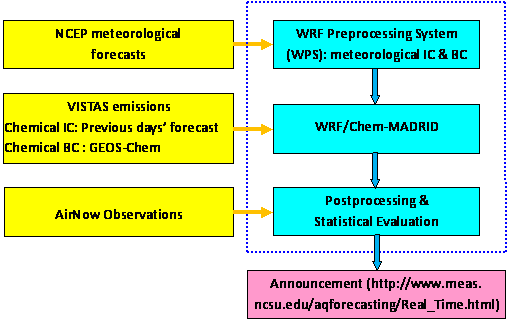|
|
Overview of CASCADE Real-Time Forecasting System
Real-time air quality forecasting (RT-AQF) has become a common practice in recent years for local and state air quality management agencies to inform the public the air pollution that may pose a risk to human health and received increasing attentions. Co-sponsored by the National Science Foundation (NSF) and the National Oceanic and Atmospheric Administration (NOAA), Dr. Zhang’s Air Quality Forecasting Lab (CASCADE) at the North Carolina State University developed a real-time air quality forecasting system that is based on the Weather Research and Forecasting Model with Chemistry and the Model of Aerosol Dynamics, Reaction, Ionization, and Dissolution (WRF/Chem-MADRID) (Zhang et al., 2004, 2005, 2008). WRF/Chem-MADRID uses the 2005 Carbon Bond gas-phase mechanism (CB05), the Carnegie-Mellon University (CMU) bulk aqueous-phase chemical kinetic mechanism, and the MADRID aerosol module. MADRID uses the sectional approach for particle size representation. It treats aerosol thermodynamic equilibrium for both inorganic and organic species, major aerosol dynamic processes such as new particle formation, condensation/evaporation, coagulation, and gas/particle mass transfer, and removal processes including sedimentation and dry and wet deposition.
The initial deployment of WRF/Chem-MADRID for RT-AQF is designed to be at a horizontal grid resolution of 12-km over the southeastern U.S. including MS, AL, GA, FL, SC, NC, TN, KY, VA, VW, and DE and portions of LA, AR, MO, IL, IN, OH, and MD. Eight particle size sections are used by default. Emissions inventories are taken from the Visibility Improvement State and Tribal Association of the Southeast(VISTAS) (http://www.vistas-sesarm.org/index.asp) and processed using the Sparse Matrix Operator Kernel Emissions (SMOKE) model (http://www.smoke-model.org) at 12-km. Meteorology is initialized using the initial and boundary conditions extracted from meteorological forecasts provided by the National Center for Environmental Protection (NCEP). The pollutant concentrations are initialized using the GEOS-Chem results and those from previous day’s forecast. Both discrete and categorical evaluations are conducted to assess the model’s forecast skills in terms of maximum 1-hr O3, maximum 8-hr O3, and 24-hr average PM2.5 using the observations from AIRnow (http://www.AIRnow.gov). The following diagram illustrates a schematic of the CASCADE’s forecasting system.

Structure of CASCADE Real-Time Forecasting System
References
- Zhang, Y., B. Pun, K. Vijayaraghavan, S.-Y. Wu, C. Seigneur, S. Pandis, M. Jacobson, A. Nenes and J.H. Seinfeld, 2004, Development and Application of the Model of Aerosol Dynamics, Reaction, Ionization and Dissolution (MADRID), J. Geophys. Res., Vol. 109, D01202, doi:10.1029/2003JD003501.
- Zhang, Y., X.-M. Hu, G. W. Howell, E. Sills, J. D. Fast, W. I. Gustafson Jr., R.A. Zaveri, G. A. Grell, S. E. Peckham, and S. A. McKeen, 2005, Modeling Atmospheric Aerosols in WRF/CHEM, oral presentation at the 2005 Joint WRF/MM5 User’s Workshop, Boulder, CO, June 27-30.
- Zhang, Y., X.-M. Hu, Y. Pan, X.-Y. Wen, Y.-S. Chen, J. D. Fast, G. A. Grell, S. E. Peckham, K. L. Schere, and G. J. Jang (2008), Updates on the development and application of WRF/Chem-MADRID, the 9th Annual WRF Workshop, June 23-27, Boulder, CO.
|




